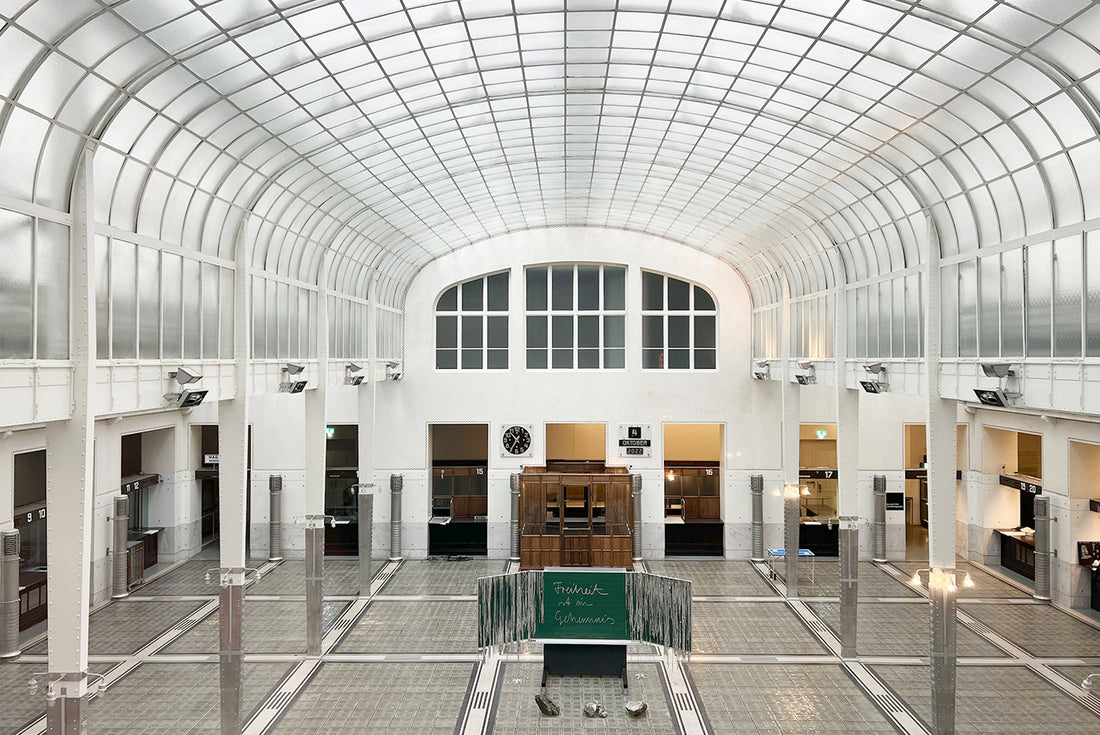
A walking tour of Modern architecture in Vienna
Share
Interested to explore the city of Vienna through its Modern architecture? Gili Merin, photographer, writer and Vienna local, takes us on a walking tour of the Austrian capital, curating an afternoon itinerary of Modern architecture, monuments and cafes to discover through her Modern Vienna Map...

All photography by Gili Merin
Postal Savings Banks, Otto Wagner
We begin our tour of Modern architecture in Vienna with the architect that, in many ways, pioneered Modernism in Vienna: Otto Wagner. While he designed many pavilions and residential blocks in the city, we will take a look at his monumental Postal Savings Banks (Postsparkasse), perhaps his most important building. The facade of this trapezoid-shaped building is clad with granite and marble plates that are dotted with aluminium bolts that may resemble a structural system but are purely ornamental. Inside, glass bricks line the floors and ceiling of the atrium, allowing natural light to filter in across the former hall, supported by ornate steel columns. Today, the former bank is used by the University of Applied Arts (die Angewandte), located just across on the Ringstrasse. Fortunately, the Angewandte Interdisciplinary Lab (AIL) runs Café Exchange in the main hall, which means visitors can enter freely during opening hours.
Coop Himmelb(l)au’s rooftop extension
Once leaving the bank, turn right and head south on Biberstrasse. As you approach the intersection with Falkestrasse, look up to find a dazzling mix of metal and glass: Coop Himmelb(l)au’s rooftop extension (1983-1988), widely considered the first project of Deconstructivist architecture.
Dr Karl Lueger Platz
Continue south for a rest in the rose garden of Dr Karl Lueger Platz, where you can examine the graffiti on the monument of one of the city’s most controversial mayors. Karl Lueger indeed modernized the city of Vienna but is also widely considered a populist antisemite who had a large influence on Adolf Hitler (who lived in Vienna during Luege’s tenure as mayor). Since the sculpture is under constant vandalism, the city initiated an artistic competition in the spring of 2023 to contextualize the monument within its troubled history and memory. The winning concept by Klemens Wihlidals (with a budget of 500,000 euros to execute) proposed to tilt the sculpture by 3.5 degrees—the tipping point where the human eye can detect an irritation—hoping to generate a debate and keep the public informed about Lueger’s legacy.

Kleines Café
From there, head deeper into the 1st district and rest at the Kleines Café. Though Vienna is known for its historic coffee houses (declared as an intangible world heritage site by UNESCO in 2011), which are often draped in velvet and heavy curtains, Kleines offers a modernist interior that includes mirrors, leather booths, and marble partitions—an obvious rephrasing of Adolf Loos’ American Bar located a few blocks away. Kleines Café was designed by local architect Hermann Czech and has become a meeting point for local artists and architects (including Czech himself) who enjoy a Wiener melange or a white spritzer from morning to the late hours of the night.

Haas Haus
From the quiet Franziskanerplatz, you can continue towards the city’s main square, Stephansplatz, where you’ll find the meeting of the city’s Cathedral – a Medieval limestone church with looming towers – with the modern Haas Haus located just opposite. This glass and stone building was designed by Hans Hollein, one of the world’s most renowned postmodern architects who famously said “Everything is architecture.” Haas Haus is a mixed-use shopping and office building with a rooftop restaurant and a subway station below. Its complex form includes a curved facade from which a mirror-clad cylindrical volume is protruded and cantilevered over the pedestrian plaza, giving the building that signature quirky Hollein look.

CM Boutique
For those who enjoyed Haas Haus, many of Hollein’s iconic shop fronts are found in the vicinity: the vintage shop CM Boutique, designed as an over-scaled ventilation shaft complete with orange plastic and dark glass; the jewellery stores Schullin I and Schullin II; and the former candle shop Retti, whose entrance is carved out of its aluminium facade between two symmetrical and angular windows, with its rectangular and reflective interior spaces.

Looshaus
We conclude the tour on Michaelerplatz. After you look at the exposed Roman Ruins (whose enclosure has been designed by Hollein, of course), take a look at the elegant building that stands out from the rest of the imperial architecture. In 1909 Loos designed a house for the manufacturing and sale of upper-class menswear. It was built of reinforced concrete (one of the first in the city), and was complete with green marble on the lower floors and simple plaster on the top ones – a stark functionalist design.
The location of the building in front of the Hofburg (the former imperial palace of the Habsburg dynasty and today the residence and workplace of Austria’s president) caused a scandal for its utilitarian, unornate facade (Emperor Franz Josef had famously called it “a house without eyebrows”). Though construction was halted in 1910 due to public uproar, it was finally completed in 1912 and was listed as a protected monument in 1947. After numerous changes in ownership, the Looshaus was finally purchased in 1987 by Raiffeisenbank Vienna which renovated it to its original form.
Loos and Wagner represent two opposing approaches to modern architecture: Otto Wagner and the Secession group celebrated Art Nouveau and decoration at turn-of-the-century Vienna, and Adolf Loos, who famously authored Ornament and Crime, a manifesto for modern architecture and the triumph of function over form. Which of the two architects had more influence on modern Vienna? You’ll have to decide for yourself.
Modern Vienna Map / Wiener Modernismus Stadtplan
Your guide to modern architecture in Vienna. Featuring remarkable examples of Modern architecture in Vienna, this two-sided bilingual guide includes a map, details of 50 buildings, an introduction and photography by Gili Merin. Featured on the map are Functionalist works by Adolf Loos, the residential blocks of Red Vienna, including the Karl-Marx-Hof, post-war Brutalist churches, Hans Hollein’s sculptural shopfronts, the world’s first Deconstructivist project, by Coop Himmelb(l)au, Hundertwasser's colourful and undulating architecture and much more.


